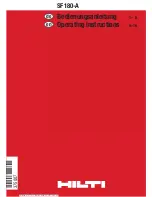
4
E
NGLISH
ws do not touch the flutes of the bit. Tighten chuck collar by hand.
Place
chuck key in each of three holes, and tighten in clockwise direction
(Figure
4). It’s important to tighten the chuck with all three holes to prevent bit
slippage. To release bit, turn chuck key counterclockwise in just one hole, then
continue to loosen chuck by hand.
Drilling
BE SURE REVERSING BUTTON IS IN THE ‘‘FORWARD’’ POSITION.
1. Use sharp drill bits only. For WOOD, use twist drill bits, spade bits,
power auger bits or hole saws. For METAL, use high-speed steel twist
drill bits. For MASONRY, such as brick, cement, cinder block, etc., use
carbide-tipped bits.
2. Be sure that the material to be drilled is anchored or clamped firmly; if
drilling thin material, use a wood ‘‘back-up’’ block to prevent damage
to material.
3. Centerpunch an indentation at the point to be drilled. This will
overcome tendency of bit to slip around on a smooth surface. Place the
tip of bit in indentation and turn drill ON.
4. Always apply pressure in a straight line with the bit. Use enough
pressure to keep the drill biting, but do not push hard enough to stall
motor or deflect bit. To minimize stalling when breaking through the
material, reduce the pressure on drill and ease the bit through last part
of the hole.
5. Hold drill firmly to control the twisting action of the drill.
6. When drilling larger holes, it is helpful to drill a small pilot
Operation
DRILLING IN WOOD
Holes in wood can be made with the same twist drill bits used for metal
or with spade bits. These bits should be sharp and should be pulled out
frequently when drilling to clear chips from the flutes.
DRILLING IN METAL
Use a cutting lubricant when drilling metals. The exceptions are cast
iron and brass which should be drilled dry. The cutting lubricants that
work best are sulfurized cutting oil or lard oil; bacon grease will also
serve the purpose.
DRILLING IN MASONRY
Use carbide tipped masonry bits. Refer to
Drilling
section. Keep even
force on the drill but not so much that you crack the brittle material. A
smooth, even flow of dust indicates the proper drilling rate.
Accessories
.
CAUTION:
The use of any other accessory not recommended for use
with this tool could be hazardous.
The following accessories should be used only in the sizes specified
below: BITS, METAL DRILLING – Up to 3/8" (9.5mm); BITS, MASONRY
DRILLING – Up to 3/8" (9.5mm); WOOD DRILLING – Up to 1/2"
(12.7mm).
We strongly recommend that safety glasses be worn when drillin
154433/-9049 SHORT2 12/8/03 10:05 AM Page 4







































